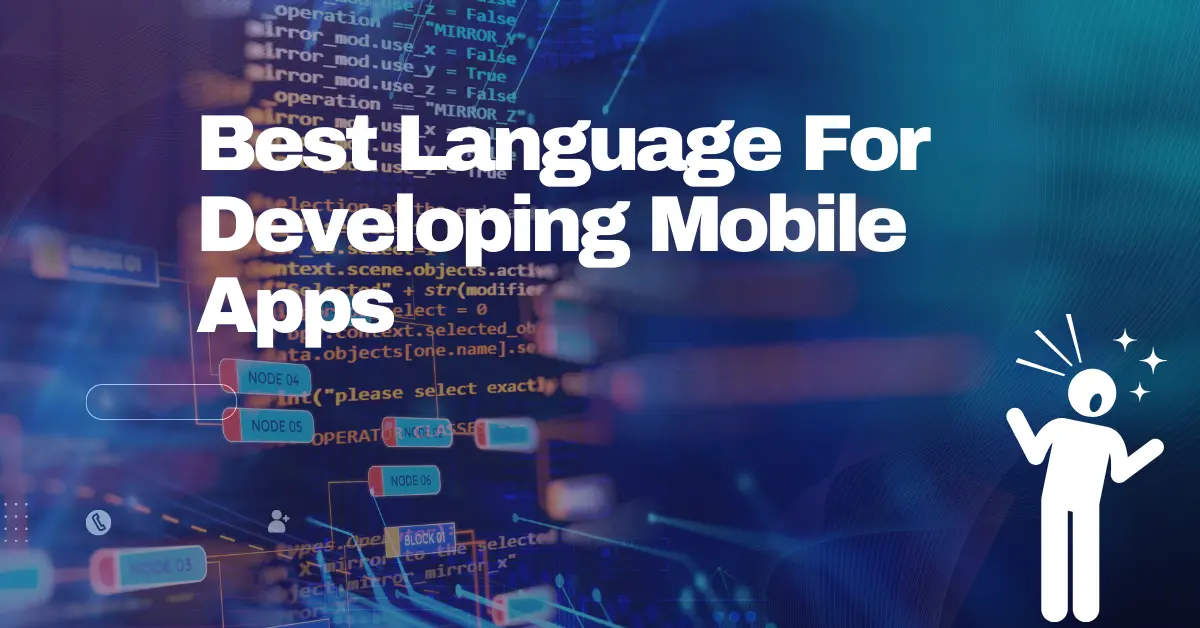I. Introduction
Choosing the best language for developing mobile apps is a critical decision for any app developer. The language you select will impact the performance, user experience, and even the development time of your mobile application. Not only this your interest and the knowledge in the language also matters in selecting the best language for developing mobile apps. If you are choosing language in which you have no knowledge or interest so it will be difficult for you to learn and to work with that language. Let’s discuss into the options available and factors to consider when deciding on the best language for developing mobile apps.
Table of Contents

II. Native App Development Languages: Best Language For Developing Mobile Apps
A. Swift (iOS)
Swift stands out as the best language for developing mobile apps specifically for iOS devices. Apple introduced Swift as a modern, fast, and secure language for iOS app development. Its syntax is concise yet expressive, making it easier for developers to write clean and efficient code. If you are using or want to use this language your work will become easy because it includes much options for developers to clean and to generate codes.
B. Java/Kotlin (Android)
For Android app development, Java has been the well known ant the traditional choice. However, Kotlin, endorsed by Google as an official language for Android, has gained popularity due to its modern features and seamless interoperability with Java. Choosing between Java and Kotlin depends on factors like developer familiarity and project requirements. If you learn Java you can make passive income by selling your services on different freelancing platforms because the java is the one which has demand in the freelance market.
III. Cross-Platform Development Languages
A. React Native
When considering cross-platform development, React Native emerges as best language for developing mobile apps. Developed by Facebook, React Native allows developers to build mobile apps using JavaScript while maintaining a native look and feel. It’s a popular choice for businesses looking to streamline development for both iOS and Android platforms.
B. Flutter
Flutter, backed by Google, has gained rapid adoption in the developer community. Using the Dart programming language, Flutter enables the creation of high-performance, visually stunning apps with a single codebase. Flutter’s hot reload feature allows developers to instantly view changes made to the code without restarting the app. This feature significantly speeds up the development process and enhances productivity. Most of the developers are using flutter as best language for developing mobile apps.
Flutter offers a rich set of customizable widgets, enabling developers to create stunning and interactive user interfaces. These widgets adhere to the design guidelines of both iOS and Android, ensuring a native look and feel.
Flutter vs. React Native
While React Native also supports cross-platform development, Flutter’s performance and UI capabilities are often regarded as superior. Additionally, Flutter’s hot reload feature is more robust compared to React Native’s hot reloading.
C. Xamarin
Xamarin, now a part of Microsoft’s .NET ecosystem, empowers developers to build native Android, iOS, and Windows apps using C#. With Xamarin, developers can leverage their existing C# skills and share a significant portion of code across multiple platforms, thereby reducing development time and effort.
IV. Comparison of Languages
A. Performance
When it comes to performance, native languages like Swift and Kotlin often have an edge due to their direct compilation to machine code. However, modern cross-platform frameworks like React Native and Flutter strive to achieve near-native performance, bridging the gap between native and cross-platform development.
B. Development Time
Cross-platform development languages, such as React Native and Flutter, offer faster development cycles by enabling code reuse across platforms. This results in shorter time-to-market for mobile apps, a crucial factor in today’s competitive landscape.

C. Community Support
The best languages for developing mobile apps boast robust community support, providing developers with access to a wealth of resources, libraries, and documentation. Whether it’s the vibrant React Native community or the growing Flutter ecosystem, strong community backing can significantly enhance the development experience.
D. User Interface
Flutter and React Native excel in delivering captivating user interfaces, thanks to their rich set of UI components and customization options. While native development offers ultimate control over UI elements, cross-platform frameworks provide a balance between efficiency and aesthetics.
V. Factors to Consider When Choosing a Language
A. Project Requirements
Evaluate the specific requirements of your project, including performance benchmarks, platform compatibility, and scalability needs. Choose a language that aligns with your project goals and technical constraints.
B. Developer Skillset
Consider the proficiency of your development team in various programming languages and frameworks. Opting for a language that matches your team’s expertise can streamline development and mitigate risks associated with learning curves.
C. Budget
Factor in the costs associated with each language, including licensing fees, development tools, and ongoing maintenance. Balancing budgetary constraints with long-term project goals is essential for making informed decisions.
D. Timeframe
Assess the project timeline and deadlines, taking into account the speed of development offered by different languages and frameworks. Prioritize languages that enable rapid iteration and efficient collaboration among team members.
VI. Conclusion
Choosing the best language for developing mobile apps is a pivotal step in the app development journey. Whether you opt for native development with Swift or Kotlin or embrace cross-platform frameworks like React Native or Flutter, consider your project requirements, developer skillset, budget, and timeframe. If you select best language for developing mobile apps your journey become easy.

VII. FAQs
A. What is the best language for developing iOS apps?
Swift is widely regarded as the best language for developing iOS apps due to its modern syntax, performance optimizations, and seamless integration with Apple’s ecosystem.
B. Is it better to use cross-platform development or native development?
The choice between cross-platform and native development depends on factors like project requirements, development timelines, and budget constraints. Cross-platform development offers code reusability and faster development cycles, while native development provides greater platform-specific control and performance.
C. How does the choice of language impact app performance?
The choice of language can significantly impact app performance, with native languages like Swift and Kotlin often offering better performance compared to cross-platform frameworks. However, modern cross-platform frameworks like React Native and Flutter strive to achieve near-native performance through optimizations and hardware acceleration.
D. Can I use multiple languages for different parts of my app?
Yes, you can use multiple languages for different parts of your app, known as hybrid development. For example, you can use Swift for iOS frontend development, Kotlin for Android frontend development, and Node.js for backend services. However, managing multiple languages may introduce complexity and overhead, so weigh the pros and cons carefully.
E. What resources are available for learning mobile app development languages?
There are numerous resources available for best language for developing mobile apps, including online tutorials, documentation, community forums, and coding bootcamps. Platforms like Udemy, Coursera, and YouTube offer comprehensive courses and tutorials for beginners and experienced developers alike. You can also watch complete cource on YouTube channel name by Tech With Sahil.
